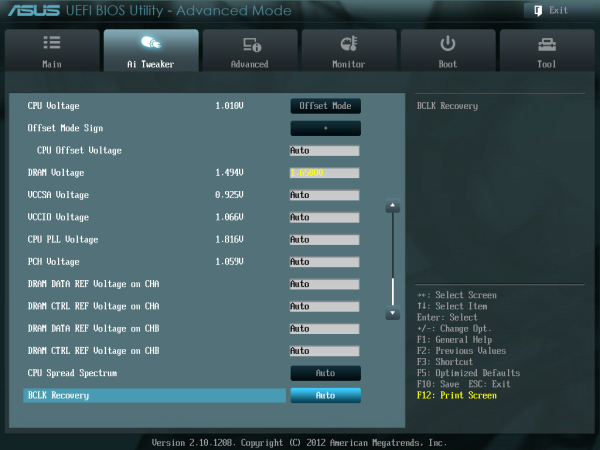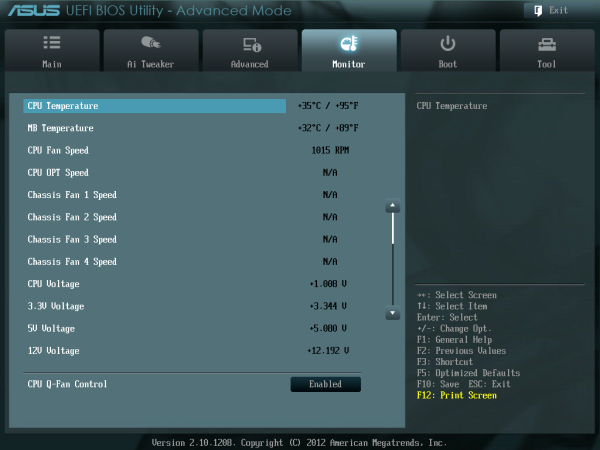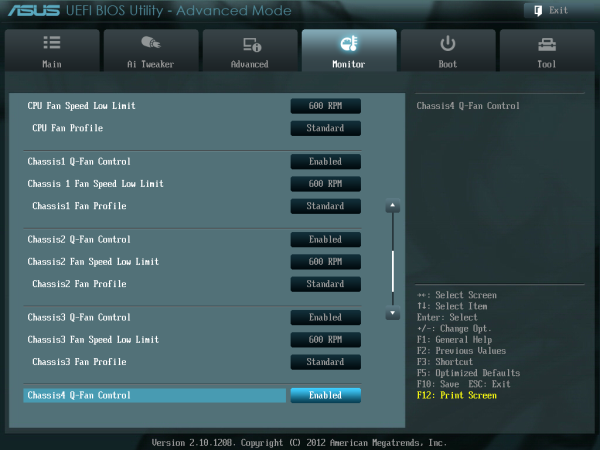ASUS P8Z77-V Deluxe Review - Know Your SKU
by Ian Cutress on May 12, 2012 8:45 AM EST- Posted in
- Motherboards
- Asus
- Z77
ASUS P8Z77-V Deluxe BIOS
In the past, when you had seen one BIOS then you had generally seen them all - white text on blue screens (or white on black if you were lucky). Now that we are firmly in an era of graphical interfaces and user operability, as users we get to see and play with the combination of designs that teams and BIOS engineers can envisage. Leading the field during P67 was ASUS, but now with Z68 and X79 out of the way, MSI and Gigabyte have been hot on their heels in an attempt to offer a superior experience.
The problem with consecutive iterations of innovation is how to innovate next - more functionality, or improvements on current functionality? ASUS will perhaps have to invest in deciding which direction to take over the next few chipsets - but nevertheless, the BIOS we have access to today is still very well thought out, easy to use, and one of the better graphical BIOS implementations for users and enthusiasts to enjoy.
The initial screen as we may all know by now for ASUS products is the EZ Mode - showing everything a user needs to know about what they have just bought or are using. We have the board model and BIOS version (always important to know without opening up a case to find out or loading CPU-Z), CPU type and speed, memory amount and speed, CPU/chipset temperatures, as well as voltages and fan speeds. For ease of use, system performance can be adjusted for low power, normal, or high performance. The boot priority is also changed by dragging drives into their appropriate positions. Pressing F3 will bring up shortcuts to the main sections in Advanced Mode, whereas F8 offers a one-time boot choice for the next boot (useful for installing OSes in my case).
Advanced mode is where the meat of the BIOS action happens as per usual, with AI Tweaker holding all the overclocking secrets a general enthusiast could want. Users coming from ROG boards will find far fewer options on the Deluxe than on ROG boards, as the Deluxe focuses on delivering secure performance rather than bleeding edge - this may discourage a few extreme (sub-zero) overclockers, but chances are those users will be heading for ROG anyway. For the rest of us, the main option is 'AI Overclock Tuner', which offers Auto/Manual/XMP options.
Under XMP, the following options are opened up, with 'core ratio limit' determining the multiplier. The BCLK Frequency is also adjustable. When pushing the CPU above 4.6 GHz, it is recommended that Internal PLL Overvoltage be set to enabled. XMP is automatically set in this mode, including memory strap, voltage and subtimings. These can also all be adjusted as required.
Voltages are set below the main settings, and the DIGI+ VRM option allows adjustment of all the digital power delivery - CPU, DRAM and iGPU as required.
The main other section of the BIOS for users is the fan controls, found in the Monitor section. This shows the current temperature and fan speed settings, while underneath gives the variety of fan controls to which we are accustomed to with ASUS - actual numbers in terms of RPM and temperatures, rather than obscure units that some other manufacturers like to use. It is also worth pointing out that alongside all the fan headers supporting 4-pin fans, the chassis fan headers also support 3-pin fan control due to the upgraded fan controllers ASUS use.
ASUS also offer saving of OC Profiles, and an easily updateable BIOS through EZ Flash as long as you have a USB stick with a BIOS downloaded on to it.
It is very hard to criticize an ASUS BIOS, as it does almost everything really well. Other features I would like to see included are perhaps an Internet BIOS Update in the BIOS (like ASRock), graphs representing the fan controls (if possible) or perhaps an option to turn off all lights on the board (for dark gaming experiences).
Software
For the last few generations of motherboards, ASUS has pushed their AI Suite software. Acting as an all-in-one interface, AI Suite aims to bring all the separate areas of ASUS functionality into the same, consistent implementation so nothing catches a user by surprise (or fills the spare memory of a PC with 18 different processes).
AI Suite covers the following features:
TurboV Evo: Overclocking Settings, Auto and Manual
DIGI+ VRM: Power delivery settings for CPU and Memory
EPU: Energy Saving
Fan Xpert II: Fan testing and controls, featuring full automatic testing of fans and user-changeable configurations.
Probe II: Monitoring of on-board factors (temperature, fan speeds, voltages)
AI/USB Charger: Quick device charging utilities
USB 3.0 Boost: Superior USB performance on any USB 3.0 port using the UASP protocol
Network iControl (NiC): Priority configuration of software through network ports
SSD Caching: Integration of Z68 SSD Caching on Z77
USB BIOS Flashback: Set up a USB to flash a BIOS without any CPU/Memory/GPU required.
Our P8Z77-V Pro review covered AI Suite II, as well as USB 3.0 performance, in detail.




























52 Comments
View All Comments
KivBlue - Saturday, May 12, 2012 - link
Don't get me wrong, I like ASUS but they are pricey for what they offer, and I think Gigabyte is decent but they lack something in software side of things, I really feel like the choices are rather limited. EVGA has a chance to step up their game and put a stamp in the motherboard market just by coming up with a 2 or 3 model line-up for Z77 chipset catered at low to mid level, because FTW at the moment is out of the price range for most people to even consider.IanCutress - Monday, May 14, 2012 - link
Hi KivBlue,We review what we get in, and we test in our spare time alongside a full time job. I currently have 12 boards in to get through, unfortunately no EVGA. We may get hold of one soon though.
Ian
jimmyzaas - Sunday, May 13, 2012 - link
Please review the premium Gigabyte UD5H board as well. I compared it closely with this deluxe board and it seemed to have everything this board has except wifi. It's also a full $70 cheaper.IanCutress - Monday, May 14, 2012 - link
Hi JimmyZaas,This board just came through my door. I have other boards to test ahead of it, and then Computex, and then I'll will have a chance to take a look.
Ian
falc0ne - Sunday, May 13, 2012 - link
both from my user and my IT experience(5 years as hardware technical support) MBs with more features are more prone to fail than others with less features.I had a Deluxe version of ASUS with the whole bulk of features, including wi-fi, dedicated antena, 24bit 192Khz audio card, lots of USBSs and SATA etc.
Problems I had :
-ASUS temp monitoring utility didn't report an accurate temperature
-wireless not reliable, support software was very poor
-After 1 year of usage blue screens with message "IRQ not less or equal". Done my own investigation and found out that enabling devices in BIOS would work. Worked for a while and now the MB even after that fix still has random BSOD + random fail to boot issues.
-
At this moment imagine that I am reluctant to buy any of these boards with 100+ features.
OK, on paper they look great, but do they actually work? Who can tell how reliable this MB will be after 1 year of usage?
My take is, mine got busted after doing a very mild overclocking. I only increased the frequency from 2.3 to 2.9 Ghz, all done by the book.
Bottom line,make a thourgh reasearch when you buy one of these
Ratman6161 - Sunday, May 13, 2012 - link
Not that many people will want to be doing that. But for the Z68 boards in the test you use a 2500K. I think it might be interesting to also see a 2500K in the Z77 boards just to see if there is any difference in performance attributable to the different chipsets. I kind of suspect there would be no difference.DarkRogue - Sunday, May 13, 2012 - link
First off, thanks again Ian for a good review.I see you've added a few more tests and are generally improving upon the last mobo review article.
I also appreciate your taking the time to try and explain the voltage ripple situation in the article, enve if I still don't quite understand it, haha.
However, one that that still puzzles me is probably one of the best features of the ASUS boards so far - Fan Xpert 2. I'm getting a lot of conflicting information about whether or not they can control the speed of 3-pin (non-PWM) fans, such as the Nexus D12SL-12 ort he newer Scythe Kama Flow 2's (which seems to have replaced the older Scythe S-FLEX series.)
I've read that the fan headers do support fan control of those fans, and also that some headers don't support it, which is very confusing. It would be extremely helpful if you could delve into the software suite and test out the fan control on a couple non-PWM fans. Furthermore, I can't find any mention if the mboo controls 3-pin fans via voltage variation, or still tries to do some kind of PWM by pulsing the 12v on and off.
In particular, not all fan headers are created equal on every mobo, so it would be helpful to know where the differences lie.
Basically, besides the hardware, every manufacturer is trying to differentiate themselves with their software suite, and it would be a good idea to try them out and note how stable/buggy they are, if they perform well, if there are any competitive products, etc.
Otherwise, I'm liking the improvements in the review.
maximumGPU - Sunday, May 13, 2012 - link
i have the board with three 3-pin fans plugged into it. Fan Xpert can control their speed just fine.DarkRogue - Sunday, May 13, 2012 - link
Which headers do you have them plugged into?I have heard that the Chassis headers can control 3-pin and 4-pin fans, but that the CPU and CPU_OPT headers can only control 4-pin fans.
Do you know if they are controlled via voltage (for example, feeding 8v to the fan) or if it simply pulses 12v on and off?
IanCutress - Monday, May 14, 2012 - link
Hi DarkRogue,ASUS confirm that the chassis fan headers (labelled CHA) should be able to control 3-pin fans.
Regarding software, AI Suite has been pretty stable for the last 6-8 ASUS boards I've gone through, so I didn't mention anything new here. If software bugs me during testing, by not doing what it should, I do mention it where I can :)
All the best,
Ian